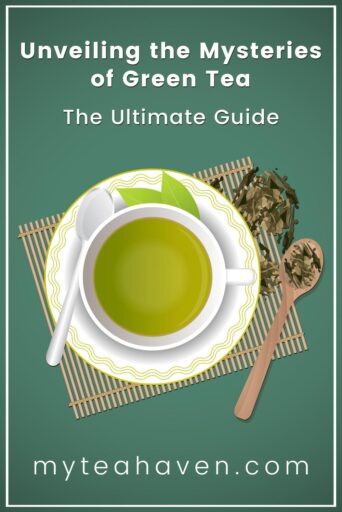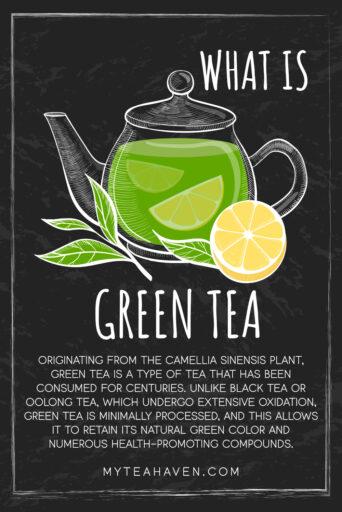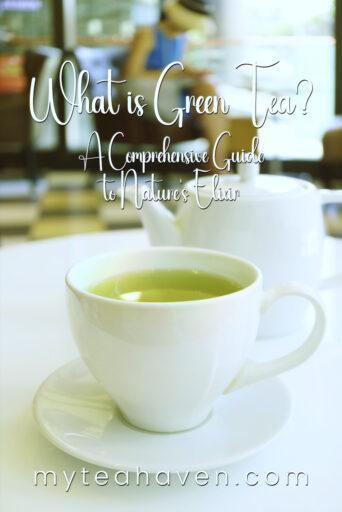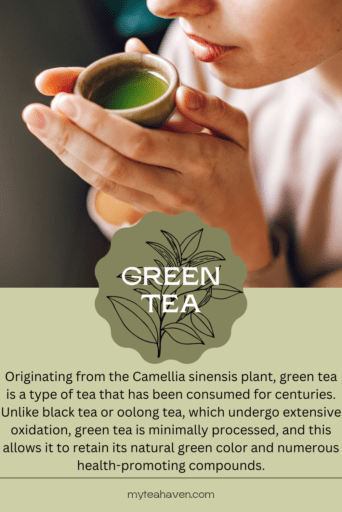Unveiling the Mysteries of Green Tea: The Ultimate Guide
What is Green Tea
Introduction
It isn’t hyperbole to say that there are many tea types, and one particular variety that stands out for its soothing flavor and unique health properties is green tea. Today we will learn more about green tea, its origin, production process, and how it differs from other teas. Additionally, I will offer valuable suggestions for brewing, choosing the best time to consume it, and factors that influence its quality. So, grab a cuppa and join me on this journey!
We are a participant in the Amazon Services LLC Associates Program, an affiliate advertising program designed to provide a means for us to earn fees by linking to Amazon.com and related sites. This post may contain affiliate links which means we may receive a commission, at no cost to you, for purchases made using our links. Please see my disclosure to learn more. Unless otherwise stated, all prices are in US$.

What is Green Tea?
Originating from the Camellia sinensis plant, green tea is a type of tea that has been consumed for centuries. Unlike black tea or oolong tea, which undergo extensive oxidation, green tea is minimally processed, and this allows it to retain its natural green color and numerous health-promoting compounds.
The leaves are steamed or pan-fired soon after plucking, preventing oxidation and preserving the tea’s fresh taste.
Types of Green Tea
This type of tea comes in various forms, each with its unique characteristics and flavors. Some popular varieties include:
Sencha
Sencha is one of the most common green teas in Japan, known for its grassy and slightly sweet taste. It is made from the top leaves of the tea plant, resulting in a vibrant green infusion.
Matcha
Matcha is a powdered green tea highly regarded for its ceremonial preparation and vibrant green color. The leaves are shade-grown, hand-picked, and ground into a fine powder. Matcha offers a rich, creamy flavor with a hint of natural sweetness.

HANDPICK Organic Matcha Green Tea Powder
What sets matcha green tea apart from other types of tea is the way it is cultivated and processed. Matcha leaves are grown in the shade, which enhances their chlorophyll content, resulting in a vibrant green color and a rich, earthy flavor. The leaves are then carefully hand-picked and stone-ground into a fine powder, ensuring that every sip of the tea encapsulates its full essence.
Dragon Well (Longjing)
Originating from China, Dragon Well tea is renowned for its flat, broad leaves and distinct chestnut aroma. It has a refreshing, subtly sweet flavor and is often enjoyed for its smooth texture.
Gunpowder
The gunpowder variant hails from China and is named after its rolled leaf pellets which resemble gunpowder. It has a bold and slightly smoky taste, making it a popular choice for those seeking a robust experience.
Production Process of Green Tea
The production of green tea involves several crucial steps to preserve its unique characteristics. Let’s explore the process:
Harvesting
The leaves are plucked when they are young and tender, usually in the early spring.

This ensures the tea leaves have a delicate flavor and contain a higher concentration of beneficial compounds.
Withering
After harvesting, the leaves are spread out and left to wither for a short period. This helps reduce moisture content and allows for easier shaping during subsequent processing.
Fixation
The withered leaves undergo fixation, a process that halts oxidation. This is a crucial production step, as it helps retain the natural green color and freshness of the leaves. Fixation is typically achieved through either steaming or pan-firing.
Rolling
Once the leaves are fixed, they are rolled to shape them into the desired form. Rolling helps break down the cell structure, releasing essential oils and enhancing the tea’s aroma and flavor.
Drying
The final step involves drying the leaves to remove any remaining moisture. This helps extend the shelf life of the tea and ensures it retains its distinct characteristics.
Brewing
To fully enjoy the flavors and benefits of green tea, proper brewing techniques are essential. Here’s a step-by-step guide to brewing the perfect cup:
Choose High-Quality Green Teas
Start with high-quality loose leaf green tea. Look for leaves that are vibrant green and have a fresh aroma.
Measure the Tea Leaves
Use approximately one teaspoon of leaves per cup of water. Adjust the amount based on personal preference and the strength of the tea desired.

Teabloom Perfect Measure Loose Leaf Tea Spoon
Tea scoop for black tea, green tea, oolong tea, white tea, chai tea, herbal tea, and spices. Perfect size for steeping the perfect cup: 1.5 tsp portion – scoops up even larger tea leaves with ease.
Heat the Water
Heat water to around 175°F (80°C). Avoid using boiling water, as it can result in a bitter taste. Allow the water to cool for a few minutes after boiling.
Steeping Time
Steep the tea for 2 to 3 minutes. Longer steeping times may result in a stronger flavor but can also lead to bitterness. Experiment with different steeping times to find your preferred taste.
Strain and Serve

After steeping, strain the tea leaves and pour the brewed tea into a teacup.
Green tea is traditionally enjoyed without any additives, but you can add a touch of honey or a slice of lemon if desired.
Best Time to Consume Green Tea
While it can be enjoyed throughout the day, certain times may offer additional benefits. Consider the following suggestions:
Morning
Starting your day with a cup of green tea can provide a gentle caffeine boost and help kickstart your metabolism. It can be a refreshing alternative to coffee and may promote a focused and alert state of mind.
Afternoon
Green tea can serve as a mid-afternoon pick-me-up, offering a natural source of energy without the jitters often associated with coffee. It can provide a pleasant break and help combat fatigue.
Pre-Workout
Consuming it before a workout may enhance endurance and fat burning. Its combination of caffeine and catechins can provide an extra boost of energy and support your fitness goals.
Evening
While it does contain caffeine, it generally has lower levels compared to black tea or coffee. If you are sensitive to caffeine, it’s best to avoid consuming green tea in the evening to prevent any potential sleep disturbances.
Factors Affecting Quality
The quality of green tea can vary based on several factors. When making your selection, consider the following aspects:
Origin
Different regions produce green teas with distinct flavors and characteristics. Some well-known regions include Japan, China, and Taiwan. Explore teas from different origins to discover your preferences.
Harvesting Time
Tea leaves harvested in early spring tend to have a more delicate and desirable flavor compared to those harvested later in the year. First flush teas, also known as “spring teas,” are highly sought after for their freshness.
Processing Techniques
The method of fixation, rolling, and drying can significantly impact the final taste and quality of green tea. Handcrafted teas often exhibit superior quality compared to mass-produced varieties.
Storage Conditions
Proper storage is essential to maintain its freshness. Store it in an airtight container away from moisture, light, and strong odors to preserve its aroma and flavor.

Dahlia White Porcelain Tea Canister for Loose Tea
Snug airtight lid and light-blocking porcelain keeps loose leaf tea fresh and dry. Exquisitely handpainted fine porcelain with a glazed matte finish; smooth finish inside and out.
Popular Green Tea Brands
Several reputable brands offer a wide range of high-quality green teas. Here are a few popular options:
Harney & Sons
Harney & Sons is renowned for its extensive tea selection, including a variety of flavorful green teas. They source their teas from different regions, ensuring a diverse range of tastes and aromas.
Tazo
Tazo offers a selection of green teas, expertly blended with herbs and botanicals to create unique flavors. Their teas are known for their refreshing and invigorating qualities.
Mighty Leaf
Mighty Leaf offers premium whole-leaf green teas sourced from organic and fair-trade gardens. Their teas are carefully selected and crafted to provide a luxurious tea-drinking experience.
Storage Tips
Proper storage ensures that your tea retains its freshness and flavor. Follow these tips for optimal storage:
Airtight Containers

Transfer your tea to an airtight container, such as a tin or a glass jar with a tight-fitting lid.
This helps prevent exposure to moisture, air, and other odors that can degrade the tea’s quality.
Cool and Dark Environment
Store it in a cool and dark place, away from direct sunlight and heat sources. Excessive exposure to light, heat, and humidity can cause the tea to deteriorate.
Avoid Strong Odors
Green tea can easily absorb odors, so keep it away from strong-smelling substances like spices, coffee, or perfumes. This prevents the tea from acquiring unwanted aromas.
A Few Final Thoughts
Green tea, with its rich history, delightful flavors, and potential health benefits, offers a captivating journey for tea enthusiasts. Its minimal processing, abundance of antioxidants, and unique taste set it apart from other teas.
By understanding the production process, brewing techniques, and factors influencing its quality, you can fully appreciate the nuances of green tea. So, embrace the tranquility of a steaming cup of tea, savor its goodness, and embark on your own tea exploration.
Some Questions You Might Have
- Is green tea suitable for everyone?
While it’s generally safe, individuals who are sensitive to caffeine or have certain medical conditions should exercise caution. Consult with a healthcare professional if you have any concerns.
- Can green tea help with weight loss?
It may support weight loss efforts due to its potential metabolism-boosting effects. That being said, it is not a miracle drink, and a balanced diet and regular exercise are essential for sustainable weight management.
- How much should I drink per day?
The recommended daily consumption varies, but 2 to 3 cups (8 to 24 ounces) per day is a commonly suggested range. However, individual tolerance to caffeine and personal health factors should be taken into consideration.
- Can green tea be consumed during pregnancy?
It is advisable to consult with a healthcare professional, as high caffeine intake may have adverse effects. Moderation is key, and opting for decaffeinated options may be a safer choice.
- Can I reuse the leaves for multiple infusions?
Yes, the leaves can be infused multiple times, although each subsequent infusion may result in a milder flavor. Experiment with different steeping times and adjust the number of infusions based on your taste preferences.








Comments are closed.